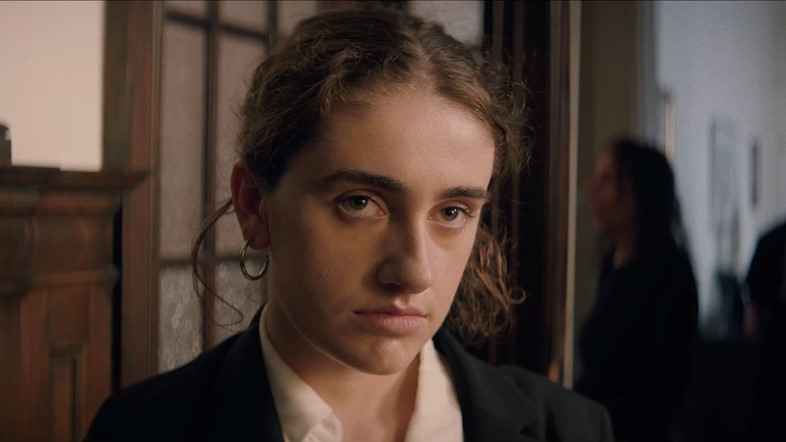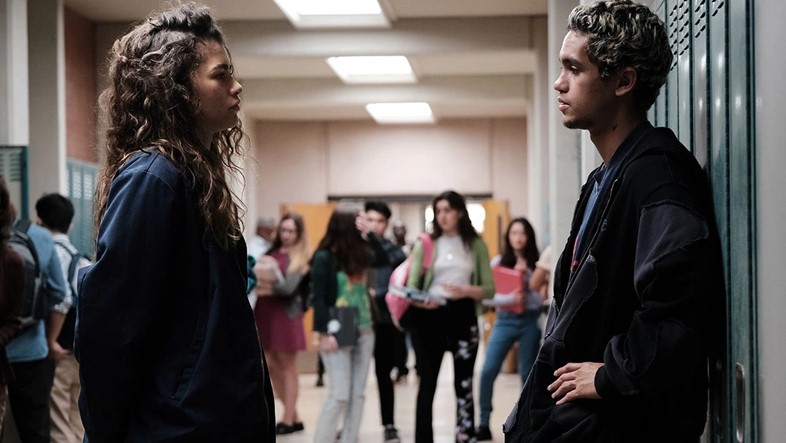Halina Reijn’s wickedly funny slasher forms part of a new wave of films and shows – from Euphoria to Shiva Baby – in which Gen-Z life is the stuff of nightmares
Bodies Bodies Bodies, Halina Reijn’s searing satire of Gen Z, opens with a genuine moment of tenderness. Amid light-dappled greenery, Sophie (Amandla Stenberg) and her girlfriend Bee (Maria Bakalova) kiss passionately, gaze deep into each other’s eyes and say, “I love you” – before we cut to them facing apart, clutching their phones close to their faces.
This quickly eclipsed intimacy, giving way to a grinding hyperpop soundtrack from Charli XCX and Slayyyter, is just one of the digs made by director Reijn at how technology has utterly transformed the way we connect with each other as human beings. Reijn’s stance, however, is not one of disapproving observer but someone who understands this struggle for close relationships all too well. “It’s relatable, right? How often do we turn away from our loved ones and start texting in our real life?” says the director.
Couple Sophie and Bee are en route to a party with Sophie’s friends at a country mansion belonging to David (Pete Davidson). (“They’re not as nihilistic as they look on the internet,” Sophie tries to reassure Bee.) The film’s cast, Rachel Sennott, Chase Sui Wonders and Myha’la Herrold, are each introduced swimming serenely in the mansion’s pool, but, when Sophie arrives unannounced, she quite literally troubles the waters. With tensions between these filthy rich characters running high, the group’s decision to play a murderous game that night, ‘Bodies Bodies Bodies’, does not bode well.

The opening scenes of Bodies Bodies Bodies have all the makings of a classic teen slasher flick, although, as it soon transpires, the film is far from a straightforward frightfest. In the classic slasher setup – think Halloween, Scream and Friday the 13th – minors are fresh meat for masked killers, flesh-eating viruses or the walking dead. Not to spoil too much, but in Reijn’s film, there is no such monster – “when the wifi goes out, the demons come in”, the director says, and her characters’ specifically Gen-Z anxieties are free to run riot. “I just put all my contemporary issues, themes and frustrations into [the slasher] format.”
“I wanted to have these characters that are both narcissistic and vain, but also very, very scared,” says Reijn. “All of us now are growing up in front of cameras. That usually would only have been actors and people in the public space, but now it’s everybody. Our fear of not being pretty enough, not being interesting enough and not being in the limelight enough is totally destroying us, it seems.”
Reijn’s feature is being released amid a series of shake-ups in the horror genre. Muscling its way into the mainstream and breaching arthouse territory, its evolution from a form once overcommitted to its own tropes led critic Steve Rose to coin the term ‘post-horror’ in 2017. With its stark emphasis on interiority and the horrors within, Trey Shults’ home-invasion chiller It Comes at Night was named as one of the first entries in this putative new genre. But it was perhaps Shults’s follow-up, Waves, that first trained a post-horror lens on specifically Gen-Z concerns, a drama true to the crippling intensity of young Americans’ emotional lives dealing with heavy topics from drug abuse to the psychic fallout from pressures heaped upon young people’s shoulders in a racist society.

While Bodies Bodies Bodies is nowhere near as emotionally wracked as Waves – Reijn’s film is, at heart, a comedy – it shares a fascination with young people navigating a world of anxiety, linking it with a new tide of films and shows including Shiva Baby, Zola and HBO hit Euphoria. Shiva Baby, another film starring Rachel Sennott, unravels with all the ratcheting suspense of a horror movie – thanks in part to Ariel Marx’s horror-inspired score – though you’ll find no axe-wielding murderers here. Instead, its jump scares come in the form of the protagonist’s sugar daddy, wife, child and her ex showing up unexpectedly at a shiva she is attending with her parents. Like Bodies Bodies Bodies, Emma Seligman’s debut feature dissects the anxieties attached to technology’s prevalence in Gen Z’s lives and all the ever-shifting ideology this entails.
Shiva Baby’s reflective yet droll exploration of feminism, financial freedom, body positivity, sex work and bivisibility feels akin to Reijn’s interest in Gen-Z issues. Bodies Bodies Bodies sometimes holds these topics up to ridicule, characters protesting about being triggered or gaslit at the smallest provocation, but the film’s take on these children of outrageous privilege is not unsympathetic. “Rachel turned to me during a dinner and said, ‘You know I have body dysmorphia, right?’” says Reijn. “And, of course, this touched my heart because I have always hated my appearance. I’ve always hated my body. But this was a consequence of my profession, I thought [Reijn worked as an actor before stepping behind the camera]. But now I see my nieces and they all have that. They even save money because they think, ‘When I grow up, I can change it all.’”
In Shiva Baby, Sennott’s character’s phone acts as a ticking time bomb. Zola, Janicza Bravo’s adaptation of a viral Twitter thread, is also punctuated by the chirrups and buzzes of notifications, as one woman is unwittingly dragged into a world of pimping and violent feuds. One especially nightmarish scene, where Stefani (Riley Keough) has sex with a seemingly endless line of men, is reminiscent of another infamous moment from recent television history, dubbed the ‘30 penises scene’.

For the latter, Euphoria creator Sam Levinson claimed he was paying homage to the iconic opening sequence from Brian De Palma’s Carrie, in which the eponymous character menstruates for the first time in a girl’s locker room. While the show, credited as “TV’s most realistic portrayal of anxiety” by Nylon, is in no way pure horror, its nods to the genre play into a wider onscreen movement linking the Gen-Z experience – particularly with regards to bodies, sexuality and identity – to a hellscape. With bleak employment prospects, economic collapse and impending climate disaster on the horizon, it's hardly surprising that this generation may see the world in shades that border on horror.
Reijn’s subversive slasher sometimes laughs at the fears of its protagonists, but ultimately, says the director, she is laughing at herself: “I don’t have children, so I feel literally like some hole in my soul has been filled by these girls, because I love them so much. I look up to them. They have taught me a lot about inclusivity, feminism, being at ease with my anxiety and my panic attacks. I used to have so many panic attacks in the wings, and I would literally go to a doctor. I would never speak to colleagues about it. This new generation actually brings an openness to that and an awareness to the point where you can make a joke about it.” The whoop and whistle of notifications flooding David’s phone, as reception is restored, is Reijn’s punchline – a reminder that, for many in the film’s intended audience, horror can be made from the raw material of lived existence.
Bodies Bodies Bodies is out now.
